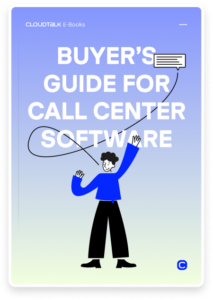10 Steps To Starting a Virtual Call Center in 2024
From a traditional model – agents answering calls on their landline phones – call centers entered a virtual era of broad business opportunities.
Today’s virtual call centers are highly profitable and easy to set up. Perhaps the best thing is that they can make the world your office.
Key takeaways:
- Virtual call centers emphasize global reach and flexibility in the modern business landscape.
- Remote call centers result in broader market outreach, reduced turnover, and 24/7 global customer service. You’ll also be cutting overhead costs with cloud-based operations.
- The process of starting a virtual call center involves identifying purpose, setting goals with key performance indicators, deciding on a budget, and choosing scalable VoIP technology.
- Incorporating comprehensive onboarding processes and regular training sessions, along with providing necessary hardware for remote agents, ensures efficient workflow setup and ongoing skill development.
Do you know how to start one? It only takes 10 steps.
Learn more about call center software in our buyer’s guide
What Is a Virtual Call Center?
A virtual call center is a modern call center, where representatives work from different places rather than a single office. This flexible setup enables seamless collaboration among virtual call center employees, whether they are working from remote offices or from the convenience of their homes. Adopting the virtual contact center (VCC) model adds flexibility and efficiency to customer interactions, creating a responsive and agile customer support system.
There is basically no difference between traditional and virtual call centers in terms of agents’ responsibilities. The true difference lies in how those agents perform their tasks. Agents in a virtual call center can attend to customers and leads from anywhere in the world via web-based customer service, such as VoIP telephony software.
Why is the virtual call center model a good idea?
For one, it allows you to keep up with current industry trends. According to Gartner, over ⅓ of customer service will be done remotely by 2023. That’s a huge difference compared to 5% back in 2017. Virtual call centers will continue to outnumber on-premises ones. That’s a fact.
Benefits of starting a remote call center
Let us quickly list them for you:
- Broader market outreach: Agents spread across various geographic areas reach a wider customer base. You will also have a better understanding of consumer demands in the regions where you operate.
- Reduced turnover: Agents working in a virtual call center are often more efficient and feel more free due to their own choice of location. Relaxed and satisfied employees are less likely to leave you for another company.
- Expended business hours: When the world is your office, you no longer need opening or closing hours. With a remote call center, you can take advantage of different time zones and serve your customers 24/7.
- Reduced overhead costs: With a virtual call center that runs on cloud-based software, you need significantly less hardware, such as physical phones. There’s also no need to pay for an office space. In this set up, to start your own call center requires very little investment. More on that later.
Starting a Virtual Call Center
By now, you may be a step closer to understanding why virtual call centers far outperform their on-premises counterparts. But you still don’t know how to actually start one. Well, not for long.
#1 Identify Your Purpose Before You Start Building Your Call Center
What do you hope to accomplish by starting a virtual call center? That’s a fundamental question you need to ask yourself. Too many businesses fail because they don’t have a clear vision..
Before you start browsing for equipment and hiring agents, decide what type of call center you need for your business.
Ask yourself:
- What is the size of my business?
- What industry am I in?
- What needs do my customers have?
- What is my primary concern – to assist my existing clients or generate new ones?
Answers to these questions should uncover whether you need to focus on inbound calls, outbound calls or perhaps a hybrid model.
Let’s look into it a bit deeper.
Inbound calls
These are incoming calls made by your customers, generally associated with customer support. Its purpose is to assist people with their issues, answer questions, help with order management, and so on.
Inbound calls aim to nurture customer relationships, provide unforgettable customer experience, support your clients’ user experience or help clients use your products and services to their full potential.
That’s why inbound calls are a main focus for larger businesses. Their goal usually isn’t so much acquiring new customers as retaining the current ones.
Focus on inbound calls if you need to provide:
- General customer service
- Technical support
- E-commerce assistance – processing payments and orders
- Help with booking of your services
- Inbound sales
The most typical industries to benefit from inbound calling:
- Finance
- Healthcare
- Retail
Outbound calls
This term refers to calls made by your agents to your clients or leads. Outbound calls are usually sales teams’ domain — their purpose is to sell or upsell a product or service.
Focus on outbound calls if you want to:
- Generate new leads
- Retain existing customers
- Start a telemarketing campaign
- Conduct market research
- Run a survey
- Set business appointments
If you own a startup or small business and want to scale up, you should definitely have an outbound team in place.
Hybrid call center
This one’s pretty self-explanatory: use a hybrid model if you’ll benefit from both inbound and outbound calls.
This model is actually a pretty smart choice, especially for mid-size businesses looking to scale. It lets you provide a full service that creates consistent experience for your customers and generates more profit for you.
Let’s say that you own a retail store. A customer contacts your support team – his or her order was lost. You can pass this information to a sales department and upsell additional insurance. Or a customer may complain about a long delivery time. What about recommending a premium subscription with delivery the next day?
Another example – you offer a CRM solution. Customers claim that your low tier plans are missing essential tools. But they don’t want to upgrade because they don’t need all the features included in more expansive plans. Here is a great opportunity to create a custom plan so your customers can choose only those tools they need.
#2 Set the Main Goal for Your Virtual Call Center
Once you’ve decided what your overarching goal should be, you need to choose the right call center metrics to follow. These will serve as your KPIs (key performance indicators) and help you track the success of your call center.
Here are 5 of the most common call center metrics that you should keep an eye on:
First Call Resolution (FCR): Also called First Contact Resolution, it is often considered the most important call center metric. It measures your ability to solve issues during your first conversation with a customer. That means without a need for a call back, follow-up calls, etc.
First Response Time (FRT): indicates the amount of time customers wait before they are connected with an agent.
Average Handle Time (AHT): Tells you how long it takes on average for your team to handle a call. It measures the time from when an agent picks up the call until the moment the call is disconnected. This metric directly links to customer satisfaction, loyalty and retention over time.
Average Abandonment Rate: This is the average number of calls that are disconnected by customers, mostly due to long waiting times. Generally, an abandonment rate lower than 5% is acceptable. Everything above it is bad news. Waiting on the line for too long is one of the top sources of customers’ frustration.
Interesting fact you may want to know: Customers are generally more willing to wait on hold for technical support than for sales support.
Customer Satisfaction (CSAT): tells you how happy customers are with your call center services.
There are many more call center metrics to follow. See more of them in our blog on 10 most important call center KPIs you should be tracking.
#3 Decide on a budget
To set up a business, you need money. First, clearly define the budget and determine how this number compares against the investment you need to start your own call center. What do you need to purchase before you start calling?
The most common expenses are:
- Salaries and insurance for employees
- A stable, high-speed internet connection
- A virtual calling system
- Basic equipment, such as laptops, headsets, screens, etc.
Other expenses may come up later, such as incentives for your best performers or a budget for team buildings. You don’t have to think about these right at the beginning, though.
#4 Choose the Technology That Fits Your Business Needs
The only reason this point ranks fourth on our list is that we wanted to build your guide from the ground up. But choosing the right virtual call center software is essential for your call center business’ success.
Continue reading to make an informed decision.First, choose a VoIP solution that integrates with all your favorite CRM, e-commerce, helpdesk or other tools. Connecting your VoIP software with the integrations you are using on daily bases will save you an incredible amount of time and effort. And if your preferred solution doesn’t integrate with all systems you’re using, search for one with an API – like CloudTalk.
Learn more about call center software in our buyer’s guide

Here’s more tools every virtual call center startup needs:
We separated our list based on necessary features for outbound and for inbound calling. You’ll also find a list of tools essential for both.
Features that all inbound call centers should have:
- Call queuing
- Voicemail
- Personalized greetings and music
- Call flow designer
- Automated call distribution
- Interactive Voice Response
- Ring groups
- Skill-based routing
- Preferred agent
- Business hours
- Call forwarding
- Callback
- Caller ID
Features that all outbound call centers should have:
- Sales dialers – Predictive, power and smart
- Outbound call center campaigns tool
- Number porting
- Automatic outbound caller ID
- Click to call
- Call statistics
- Call recording and monitoring
- Real-time dashboard
Features useful for both outbound and inbound call centers:
- Call tagging
- Call notes
- Contact tags
- Real-time customer card
- After call flow
- Contact history
- Top-class security
Before you research VoIP software options, keep in mind one thing: your solution needs to be scalable. Your business will grow, that’s your aim. And your aims will grow with it. Always look for a system that provides you with a long term solution.
#5 Focus On Hiring Talent, Wherever It Might Be
With no geographical boundaries, the world gives you 4.5 billion potential candidates. And there’s no shortage of people who prefer working from home. You can search for anybody, anywhere. That allows you to find the best talent. Top-of-the-field agents that you can trust to always make customers happy. In the end, your call center will only be as good as the people who work there.
In the endless pool of talent, search for people who:
- Work well under pressure
- Aren’t afraid to ask questions when they’re not sure about an answer
- Are disciplined and motivated enough to work even when not directly seen
- Obviously, are great with words – both spoken and written
- Ideally have experience with the systems you’re using
One more piece of advice for this step: Dream big, but scale small. It’s better to hire a smaller group of dedicated agents who can handle an extensive workload than start off with a large team. Not only is it a difficult task to manage a huge amount of people right after you start your own call center, you can also run into budgetary issues. You need to pay fair salaries for everyone.
#6 Invest in Proper Onboarding and Regular Training
No matter how experienced your agents are, you can’t expect them to know everything the very moment they start working. A well-managed onboarding process has an enormous impact on your business’ success. Why?
Not only does it build a long-term foundation for the team, but according to a Glassdoor survey, onboarding improves a company’s retention rate by 82% if conducted properly.
But building a competent team doesn’t end with onboarding. You have to create a consistent process of learning. About everything – new tools, policies, procedures. Anything that helps agents do a great job.
How can you educate your agents:
- Regular trainings
- Weekly meetings
- 1-on-1 consultations with performance and overall satisfaction overview
- Digital knowledge base with FAQs
- Customer service training manual
Prepare for these properly. Use advanced call center tools to analyze your agents’ performance and understand their strengths and weaknesses. Statistics help you to track long-term performance. Call monitoring shows you how agents interact with customers and call recording gives you an opportunity to present the best practices to other agents.
#7 Decide What Equipment Your Agents Need to Succeed
With VoIP virtual software, the need for hardware in your remote call center is heavily reduced. But you still need basic equipment. Choosing well does affect your agents’ satisfaction and performance, and of course, customer satisfaction. People are not overly keen on communicating with agents whom they barely understand.
Hardware equipment your agents will need:
- Company-issued laptop with the latest operating system. Technically, this is not a requirement. With VoIP software, agents can work from their own devices. But it does show that you care about your employees.
- A monitor to connect with a laptop. Working on a larger screen provides a better working experience. It’s a good idea to invest in a privacy-polarized screen to protect customers’ data.
- A keyboard and ergonomic mouse
- Quality headset. Choose one that has enough sound dampening. That prevents a caller from hearing background noise. A good idea is to issue two headsets – one for immediate use and one to use as a backup.
- A two-factor identification device, e.g. mobile phone. This is for logging in to your systems safely, without a risk of a security breach.
- Don’t forget about fast internet connection. At least 10 Mbps.
We recommend testing the equipment that you are about to purchase before investing in it and shipping it to your agents’ home offices.
#8 Set Up Proper Workflows for Efficiency
So far, we gave you a lot of steps on how to start a virtual call center. But how to start a virtual call center that runs truly efficiently? You need to stay organized, with an emphasis on “stay”.
Start with putting together company policies that your team should follow. It keeps everyone on the same page.
Then, set rules of how different aspects of your call center business will run.
Here are examples of questions you need to ask yourself:
- How will you distribute calls?
- What automation and call distribution tools can you benefit from?
- What will agents say once they answer the call?
- Will you use call scripts?
- What will be an escalation protocol?
- How often will you make a performance review?
Speaking of call center tools, let’s take a quick look at how technology can help you set up your workflow.
A well-equipped VoIP software offers many productivity tools that can help to automate your workflows. Think about what type of call center you run. For sales, you can create automated emails. An email will be sent each time callers say they are interested. For customer support, there are tools like IVR flows that help callers connect to the right person or department.
Let’s take a few CloudTalk’s tools as further examples. Our workflow automation eliminates unnecessary, time-consuming tasks inside of our system as well as other systems you have integrated. You can also create tickets and tasks or edit orders in your integrated solutions directly in CloudTalk. If you have many contacts, compile them in a single contact list.
#9 Build a Good Culture in Your Virtual Call Center
There’s an issue with remote workplaces. People often underestimate the importance of company culture. Just because you’re not sitting next to each other doesn’t mean you’re not a team.
Once all necessities of establishing a virtual call center are taken care of, take steps to make sure that your workplace is a supportive one. Everyone, no matter what position they are in, needs to feel valued.
What can you do to build a healthy remote company culture?
- Make a set of company culture guidelines so everyone knows what your common values are.
- Make regular team and 1-to-1 meetings to keep a personal contact, but also to see how employees feel.
- Organize virtual team buildings. Forget work talk for a bit and get to know each other on a personal level.
- Once in a while, if your budget allows, pay for transportation and organize an in-person meetup.
- Praise agents for their hard work. Don’t only celebrate big wins. Find time to stop and appreciate small ones.
- Hand out incentives for exceptional performance.
- Don’t overwhelm your agents – Burned out employees are no use to you. They may face a lot of stressful situations, for example dealing with angry customers. Grant them regular breaks and enough time off.
- Don’t encourage overworking.
- Deploy employee benefits. For example, paid flexible time off is a popular choice. In CloudTalk, it works wonders.
#10 Promote Your Call Center Everywhere
You set up an amazing virtual call center. You put all your effort, time and resources into it and you’re ready to succeed. Right? … Wrong. Not just yet.
One last brief but crucial piece of advice: promote your call center everywhere you can. Put contact information in a visible place on your website. Highlight it in your social media accounts. Include it in an electronic signature in your email.
Let people know where you are and they will start calling, seeking advice. Consequently, your customer satisfaction and loyalty metrics will start to grow.
Building a Call Center: Checklist
Identify the purpose of your call center
You asked yourself:
- What is the size of your business?
- What industry are you in?
- What needs do your customers have?
- What is your primary concern – to assist existing clients or generate new ones?
Consequently: Do you need an inbound, outbound, or hybrid call center?
Set the main goals
- Which call center metrics will you measure?
- What are your KPIs for each of them?
Decide on a budget
You have enough money for:
- Salaries and insurance for employees
- A stable, high-speed internet connection
- A virtual calling system
- Basic equipment, such as laptops, headsets, screens, etc.
Choose the right calling software
- The solution integrates with all your favorite CRM tools
- The solution has all features your business needs
- The solution is scalable
Hire the best talents – wherever they are
You put together a team of agents who:
- Work well under pressure
- Aren’t afraid to ask questions when they’re not sure about an answer
- Are disciplined and motivated enough to work even when not directly seen
- Are great with words – both spoken and written
- Ideally have experience with the systems you’re using
Invest into onboarding and trainings
- You created guidelines for internal company policies
- You have a digital knowledge base with FAQs
- You know which methods will you use to educate your agents
- Your VoIP solution has all the performance tracking tools you may need
Decide on equipment
You thought of everything your agents will need:
- Company issued laptop with latest operating system
- A monitor to connect with a laptop
- A keyboard and ergonomic mouse
- A quality headset (+ one as a backup)
- A two-factor identification device
- Fast internet connection
Set up proper workflow
You determined:
- How will you distribute calls?
- What automation and call distribution tools can you benefit from?
- What will agents say once they answer the call?
- Will you use call scripts?
- What will be an escalation protocol?
- How often will you make a performance review?
Build a good company culture
- You have a company culture guidelines in place
- You know how will you collect data on employees’ satisfaction
- You set up a reasonable workload
- You have enough budget for teambuilding, incentives, fair salaries, etc.
Promote your call center everywhere
- Your call center contact details are on a visible place on your website
- Your call center contact details are publicly visible on all of your social media accounts
- Your call center contact details are in an electronic signature of your email
Start a Call Center Business Today
So, you are now 10 steps closer to a successful virtual call center. And we would like to get you even further.
So, why should you start the journey with our solution?
CloudTalk is a top-class cloud calling system for support and sales teams that gives you over 70 advanced features and 30+ integrations.
You can build a global presence with 160 international numbers.
Grow with us.
What did you find in this article?
How to start a virtual call center business?
When starting a virtual call center business, start with defining its purpose. Then, do the following:
▪️ set basic metrics and main goals,
▪️ think of your budget,
▪️ create your call workflow,
▪️ recruit the best agents for call center,
▪️ find new potential clients for your services,
▪️ invest in a call center software,
▪️ purchase the necessary equipment,
▪️ choose the best software integrations.
How to start a virtual call center?
5 easy steps on how to start your virtual call center:
1. Specify the focus of your virtual call center
2. Determine your budget
3. Choose & implement the right software
4. Set up the right metrics and KPI’s
5. Don’t underestimate analytics
6. Hire a team of a call center agents
7. Focus on ongoing training for your agents
8. Start with basics and slowly iterate your processes
How to start a virtual call center from home?
If you’re planning on starting a virtual call center from home, you have to hire reliable virtual call agents. Except for this, you need effective tools, such as call center software for remote work. Choose the right equipment to make your agents’ work as smooth as possible. Next, plan your activities and set up proper communication with both your team and your customers.
How much does it cost to start a virtual call center?
Costs may vary a lot, depending on your location, the features you offer, and the equipment you supply.
Here are some cost estimates:
– Outsourcing starts at $10 to $20 per month and goes up to $1,200 per month or higher
– A call center service pack costs you between $20 and $30 per month
– Auto attendants usually cost $10 to $20 per month
– Supervisors costs are around $120 to $150 per month
– Standard agents cost are $80 to $100 per month
What influences costs of a call center?
There are several factors you need to consider in order to determine this. Such as:
▪️ Hardware is the most expensive investment. Consider what equipment you need.
▪️ The more agents you have, the higher are your total costs of the call center.
▪️ The location of the call center is an essential factor. It is crucial in which country you will establish it.
▪️ If you want your call center to do well, top performing agents are a necessary investment. You also have to pay for their ongoing training.




















